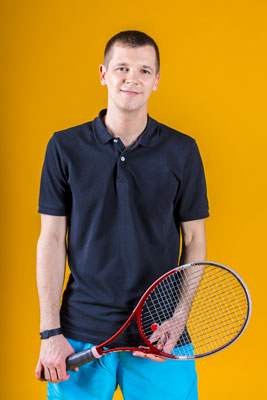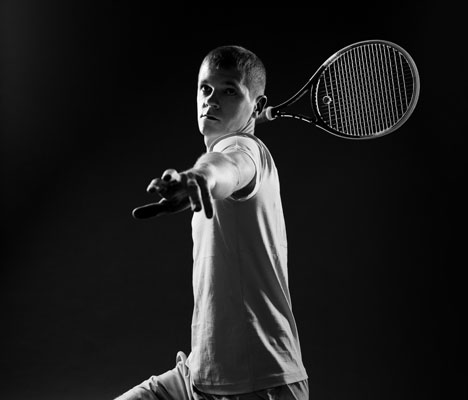I am fond of tennis and spend all my time on courts since childhood when my parents introduced me to the tennis racket. Every morning I greet the surface happily; as the night comes, I feel disappointed to leave the court until tomorrow.
I also feel very disappointed seeing the professional tennis players focused on actively fighting their weaknesses while not devoting enough time to improve their strengths. The result of such overlook is costly: they become just ordinary through the use of the wrong skill balancing strategy. At the same time, for me it is clear that each tennis player is born with a gift to be invincible. Realizing that fact, and seeing how they struggle, I made helping them a personal matter, a job for life. Over time I developed and implemented the coaching methodology that eliminates weaknesses through the continuous improvement of strengths. It is sports and psychology, combined. And here is how it works.
Let us start with the general plan before digging into detail. The most significant areas of professional tennis player development are the technique, tactics, physical training and psychology. They are equally important, and all of them must be worked on in parallel in order to grow the perfect athlete. However, there is an order in which the development of a certain area comes into play. For instance, it would be useless to learn the game tactics without knowing how to keep the tennis ball in play. So, the technique comes first. The player should learn to keep the ball in play, to properly position themselves on the court, to make the opponent move, as well as learn some tricks that would help them stay concentrated and cold-minded during each point in the match. Once the player has the technique, the coach moves on to tactics and psychology. The physical training happens all the time, in no particular order, because it is the base of the sports and must be performed both inside and outside the court.
Now, let us go back to the player’s strengths. It is highly important to identify them properly as they form the base of the whole training process. All further training is planned based on strengths. To determine them, the coach at first has to observe the player’s behaviour during practice and see what decisions they make during the free-style and score-based play. They should accurately analyze how player’s behaviour changes with or without coach’s advice.
Second thing that helps identify player’s strengths and plan the appropriate training course is keeping the precise record of athlete’s scores in the tournament matches. It is important to account player’s statistics on different types of court surface and on the variety of opponents with different styles of play. Based on this data the certain conclusions could be made, for ex. what types of tactics and strategy work best for the athlete, what physical capabilities play the primary role in them winning the points, and what emotions (or their absence) help player stay concentrated during the time of a point or the whole match.
At third, the coach must pay specific attention to the personal opinion and thoughts of their student player. These could be collected during the friendly conversation between the coach and their athlete after each practice session or a played match. Being much more experienced than their student, the coach should express sincere interest in the inner self of the athlete, ask game-related questions and let student make their own conclusions. This is how the personal connection and trust are made between the parties. Tennis is an individual kind of sports, and the higher is the level of the player, the stronger is their self-confidence, and the more important is the need for the coach to demonstrate them how valuable are their personal opinions. The non-listening coach is risking their authority in the eyes of their athlete, and that will negatively affect the whole training process. Even though the coach has their professional opinion on the athlete’s behaviour in different circumstances, the cases when such opinion is wrong are not quite rare. For instance, it could look from the distance that the player is risking too much by performing the early attacks and shortening the overall time of play, but at the time of post-game conversation the coach may learn that their student was tired and could not stand longer points, and that fact would clearly explain their chosen strategy. That is how the friendly conversation helps add up to the list of the player’s strengths.
Overall, experimenting and analysis will take some time, but the final outcome should be the clearly identified list of athlete’s strengths in tennis. Based on that list and on certain forecasts that the coach could make based on their intuitive understanding of the player’s personal characteristics, the coach will develop the individualized training plan for their student. Over time, as the player progresses, the list of strengths will change, so the coach must revisit it frequently and take care of the updates.
Now, let us say couple words about the development of player’s strengths. At first hand, the coach should set the achievable goals for their student and agree with them on the terms of their achievement. The trick here is that goals should be mostly based on the use of player’s strong sides. Together, the coach and the athlete work towards the identified goals. As the goals are strength-based, the athlete is very well motivated along the way, because it seems to them like they can meet them easily. While the player works on the result, the coach has to carefully measure all parameters involved. His task is to identify which of weak sides of their student are standing on his way of meeting the goals. He has to communicate his findings to the athlete. Being emotionally charged, the athlete would most likely want to fight the weaknesses in order to get things done. And once it becomes a personal matter for the athlete, the coach could be certain that the weaknesses will be taken the necessary care of. They are eliminated naturally, without the need to convince the player about their importance, with all necessary motivation and energy that the coach would have to grow in the student otherwise; with the enthusiasm that is a required requisite of every learning process.



Add Comment